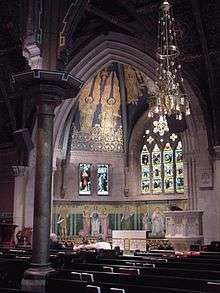Sage Chapel

Sage Chapel is the non-denominational chapel on the campus of Cornell University in Ithaca, New York State and serves as the final resting place of the university's founders, Ezra Cornell and Andrew Dickson White, and their wives. The building was a gift to the university of Henry William Sage and his wife.[1]
Design
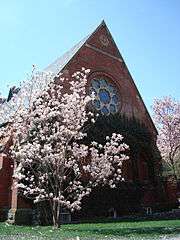
Designed by the Reverend Charles Babcock,[2] also a Professor of Architecture at Cornell, opening services were held on June 13, 1875 with Reverend Phillips Brooks of Boston's Trinity Church presiding.[3] Further additions in 1898 and 1904 created the apse at the end of the sanctuary as well as space for the mausoleum.[1] The mosaic decoration of the apse was created by J&R Lamb Studios of New York; preliminary designs for this work can be found in the Lamb Studio Archive in the Library of Congress. In 1940, another expansion and renovation added more space for a new choir loft and the current pipe organ, a 3-manual Aeolian-Skinner with 69 stops and an estimated 3858 speaking pipes.[4] The organ incorporates several ranks of pipes from previous instruments, including two of the previous organs built in the chapel.[5] The building includes Tiffany glass windows[2] and a stained glass memorial to three civil rights workers (one of whom was a Cornell alumnus, Michael Schwerner), murdered during Freedom Summer.[4]
Interior
The interior building has a rich and detailed history with many of the artistic renderings representing numerous Christian and educational themes. The olive vine theme on the floor and walls is a symbol of fertility. The double crosses in the ceiling have a blue background in which are set gilded sunbursts and stars, while in the centers are found the Greek letters, XP, which began the word Christos, and the Alpha and Omega. The colours also are symbolic; white is for purity, innocence, and faith. Black and white together, purity of life, and humiliation. Red is for fire, heat, and the creative power. Red and black together, purgatory and the realm of Satan. Green is for hope, of victory and immortality. Grey is for mourning and innocence accused. Blue for the firmament, truth, and constancy. Gold is the sun and goodness of God. The anchor represents hope and patience. The lamp is piety and wisdom. The lamb and pennant, represents the Redeemer. The cross is for redemption. The interwoven triangles, represents the Trinity. The Lion is for the Tribe of Judah. The open book with a hand pointing to the Beatitudes, is a symbol of the Gospels. The sword and palm is for martyrdom and victory. The chalice is for faith. The flaming heart is of fervent piety and love. The standard, the wreath, and the crown represent victory over evil. The sun, stars, and crescent moon, are the luminous nebula which emanates from and surrounds the Divine Essence. The burning bush is for the fervor of the martyrs. I.H.S. originally were the first three letters of the name of Jesus in Greek, but which in Renaissance time were said to stand for Jesus Hominum Salvator, "Jesus, Saviour of men."
History
The chapel is located on Ho Plaza, across from Willard Straight Hall and next to John M. Olin Library, John McGraw Tower, and Barnes Hall.
Sage Chapel has hosted many speakers, including Lyman Beecher, John R. Mott (Cornell class of 1888), Mordecai Wyatt Johnson, Harry Emerson Fosdick, Stephen Wise, Martin Luther King, Sr., Martin Luther King, Jr., Reinhold Niebuhr, Paul Tillich, Elie Wiesel, Abraham Heschel, Hans Küng, Harold Kushner, Elizabeth Kübler-Ross, Carl Sagan, Jane Goodall, Arianna Huffington, and Peter Gomes.[4]
Father Robert S. Smith (1932–2010), Catholic priest, author, and educator, preached regularly at Sage Chapel from 2002 to 2010.
Besides the university founders and chapel benefactors, others interred there include University president Edmund Ezra Day and his wife, former New York Governor Alonzo Cornell, philanthropist Jennie McGraw, her father John McGraw, and her husband,librarian & book collector Willard Fiske.[4][6]
Sage Chapel is a popular choice for couples getting married at Cornell.
Sage Chapel also serves as the home of the Cornell University Glee Club and Cornell University Chorus.
Gallery
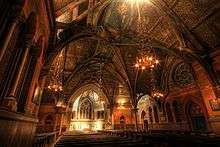 The interior of Sage Chapel.
The interior of Sage Chapel..jpg) West elevation.
West elevation.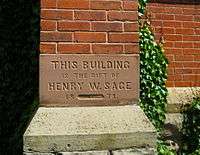 Cornerstone on the South elevation.
Cornerstone on the South elevation.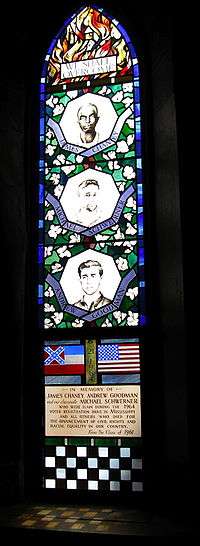
- Andrew Dickson White's sarcophagus
- Ezra Cornell's sarcophagus
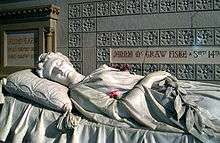 Jennie McGraw's sarcophagus
Jennie McGraw's sarcophagus
References
- 1 2 http://www.cornell.edu/search/index.cfm?tab=facts&q=&id=630
- 1 2 Rambusch, Viggo Bech (1999). "Re-Lighting a Historic Church Interior: Challenges at Cornell University's Sage Chapel". APT Bulletin. Association for Preservation Technology International. 30 (2/3): 56–9. doi:10.2307/1504641. ISSN 0848-8525. JSTOR 1504641 – via JSTOR. (registration required (help)).
- ↑ "''Cornell Chronicle'', "CURW, Sage Chapel host events to celebrate dual anniversaries" April 5, 2005". News.cornell.edu. 2005-04-07. Retrieved 2012-01-06.
- 1 2 3 4 "CURW - Sage Hall History". Curw.cornell.edu. Retrieved 2012-01-06.
- ↑ "Aeolean-Skinner Organ". Cornell University Dept. of Music. Retrieved 2012-10-05.
- ↑ Lawrence Kestenbaum. "Sage Chapel". Political Graveyard. Retrieved 2012-01-06.
External links
![]() Media related to Sage Chapel (Cornell University) at Wikimedia Commons
Media related to Sage Chapel (Cornell University) at Wikimedia Commons
Coordinates: 42°26′50″N 76°29′04″W / 42.447211°N 76.484452°W
